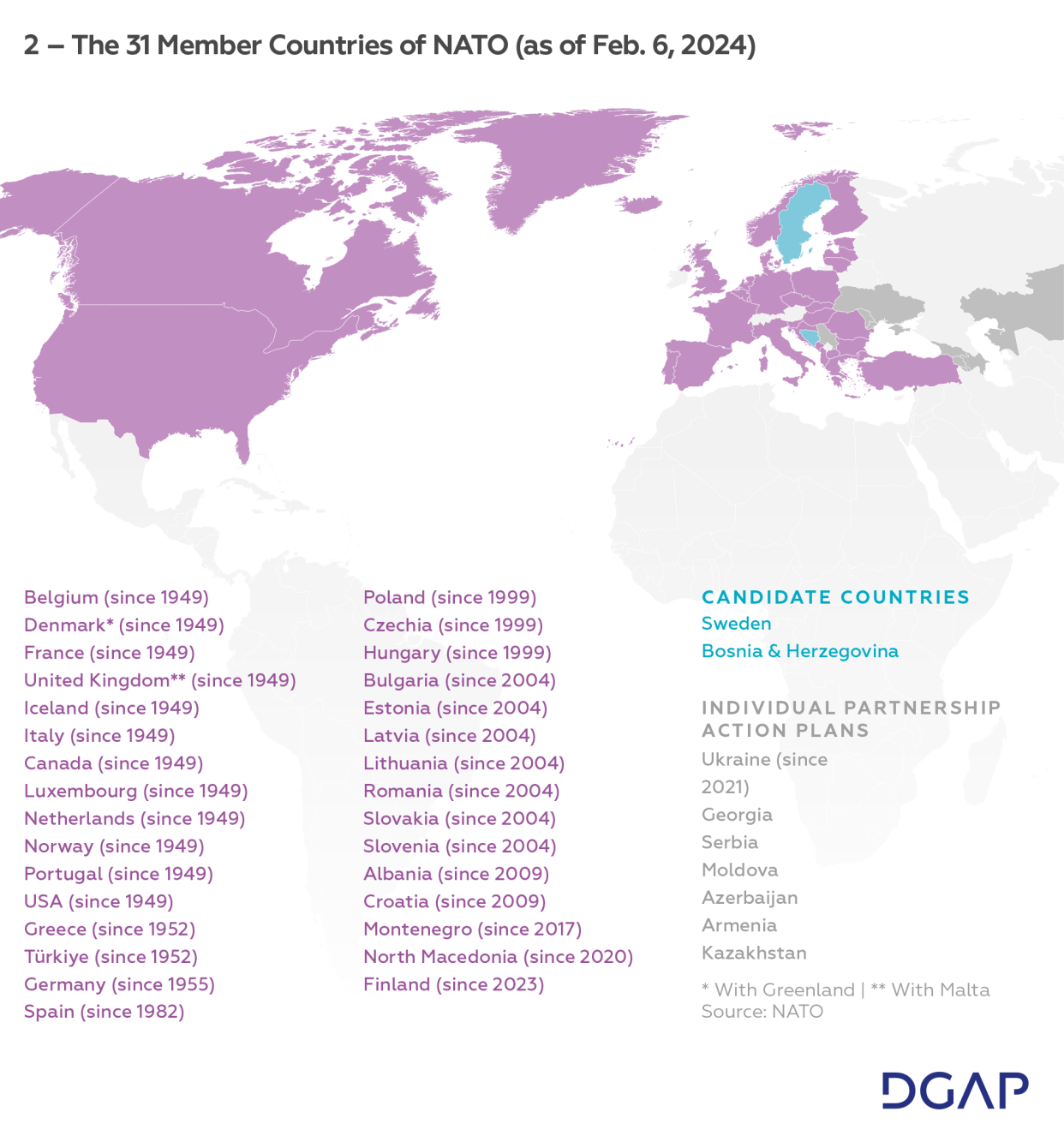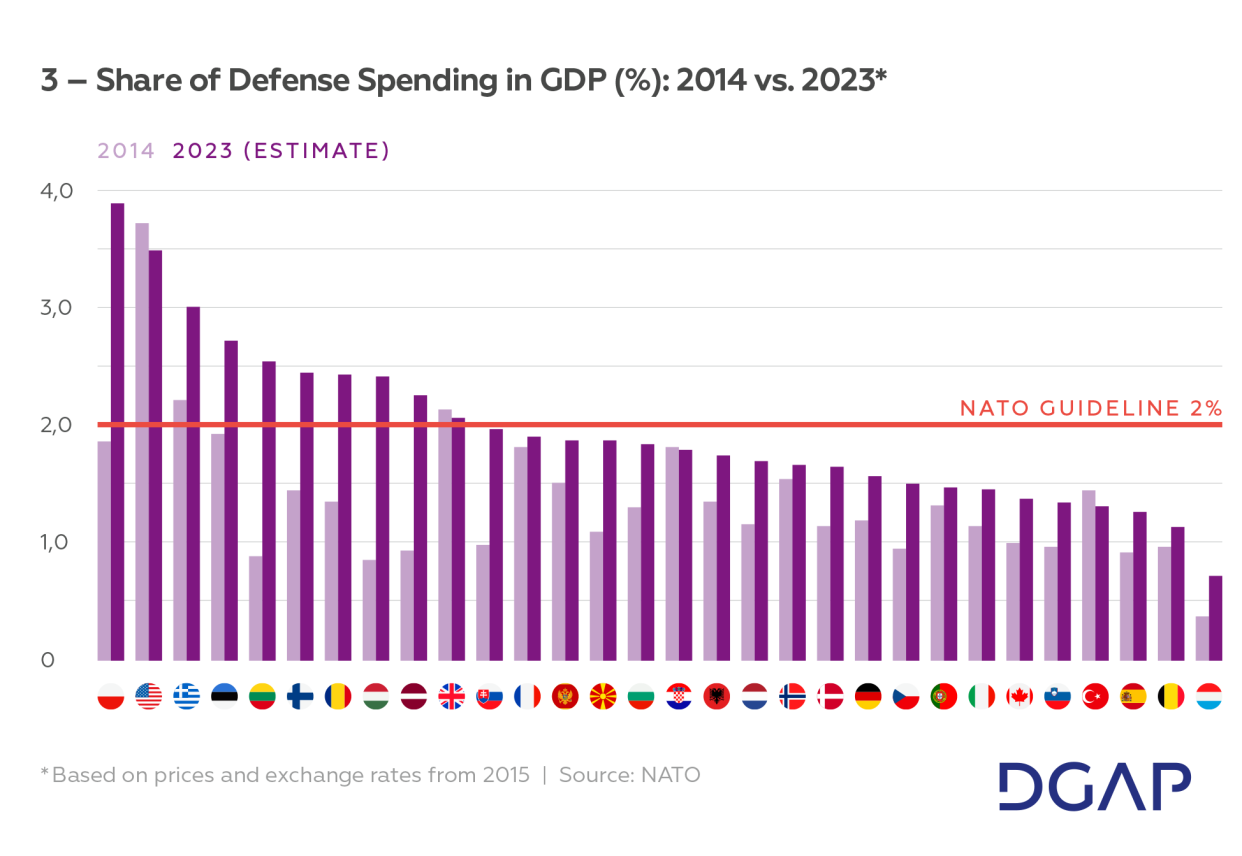The online version of this Analysis does not contain footnotes. To view the footnotes please download the pdf version here.
|
NATO should swiftly provide Ukraine with a perspective for membership, as there are no reasons for further hesitation. |
|
In light of the threat from Russia, it is important to reiterate that members should adhere to the NATO target contribution of 2% of GDP. |
|
Future partnership policy should follow three principles: interest-oriented, values-oriented, hierarchical. |
|
To unite the role of nuclear weapons in the Alliance under a strategic umbrella, a new political consensus paper is urgently needed. |
| The potential return of Donald Trump shows that transatlantic relations must urgently and sustainably be fortified against attempts from within to weaken it. |
Executive Summary
On July 11, 2024, the heads of state and government of NATO member states will meet in Washington to mark the Alliance’s 75th anniversary. For some years now, it has become an inglorious practice to hype every NATO summit as a momentous and historic event. However, this summit is indeed something special, not just because of the anniversary. First, a successor must be found for Secretary-General Jens Stoltenberg, the former Norwegian prime minister who has served for a decade in the post. Second, it is above all the mass and magnitude of current security crises that distinguish this meeting from others. These include not only Russia’s war against Ukraine, but also the upcoming US elections in November and concerns about the return of Donald Trump. Trump recently riled Western allies with threats he might abandon NATO members or even encourage Russia to attack them if they don’t fulfill budgetary targets. It would be ironic if Trump were the galvanizing force for NATO allies to finally make headway on contentious issues at the summit and secure the transatlantic relationship for the future.
Seven topics are likely to dominate the summit agenda:
-
A new secretary-general for the “community of values”
-
An accession perspective for Ukraine
-
The military adaptation of the Alliance
-
The reform of NATO partnerships
-
NATO’s role on its southern flank
-
The strengthening of nuclear deterrence
-
Strengthening transatlantic relations
NATO must elect a new secretary-general in 2024. So far, the search has been difficult, as the highest NATO position not only requires the support of the US, the Alliance’s strongest power, but also the wishes of the smaller NATO members. Regional characteristics must also be considered. However, there are currently no obvious candidates or member states that can unite the different preferences of all NATO countries. In addition to the choice of leadership, NATO will also have to address its self image as a democratic community of values. This has never been flawless. In the 1970s, NATO included military dictatorships in Portugal and Greece. Today, the question of shared values is once again being raised with regard to Turkey and Hungary.
The key summit topic is likely to be the question of Ukraine’s NATO membership. No common position could be found at the 2023 summit in Vilnius. Even today, NATO is still a long way from unity on the Ukraine issue. However, three factors speak against further procrastination. First, Ukraine’s fight for freedom and democracy demonstrates that it is ready for membership, as it represents the values and goals of the Alliance. Second, Ukraine now has battle-hardened armed forces that can make a significant contribution to its own national defense. Third, Russia is losing more and more soldiers and modern military equipment, which cannot be produced in sufficient quantities due to the international sanctions. In any case, further postponement of the Ukraine issue will hardly be possible given the danger Russia poses and the symbolic significance of the anniversary summit.
NATO had already made fundamental changes to its military planning following Russia’s illegal annexation of Crimea in 2014, as Russia was once again seen as a potential military threat. These plans will also be a summit topic in 2024, as military adaptation requires considerable financial resources. For years, many NATO members have ignored their promise to spend two percent of their gross domestic product (GDP) on defense, including Germany. However, as a result of the Russian invasion of Ukraine and the ensuing change of times, or “Zeitenwende,” the German government has set the course for meeting the two percent target in the future. For member states still falling short of a sufficient contribution to defense, this target must be repeatedly addressed and emphasized at the highest political level. Only through such “blaming and shaming” can sufficient political pressure be brought to bear.
Another recently neglected area of NATO is partnership policy. This will become even more important in the future, as the next challenge already lurks behind the Ukraine conflict, namely, an increasingly aggressive China. If partnerships are to be used sensibly in the future, a fundamental reform is required. Germany already developed initial ideas for a reorganization of partnerships at the beginning of 2023. This was based on three considerations: First, NATO partnerships must be fundamentally interest-oriented and viewed from the perspective of usefulness for both sides. Second, partnerships cannot be free of hierarchies. Partners are relevant in different ways due to their geostrategic location, political system or contributions. Third, as the Alliance is a values-based community, special importance should be attached to democratic states. If the heads of state and government in Washington ignite a reform of partnerships along these basic lines, this can strengthen NATO as a whole.
For years, there has been an East-South divide in the Alliance. While the Northern and Eastern Europeans point to the Russian threat as the Alliance’s primary area of action, southern neighbors such as Italy, Spain, Greece, Turkey, and France fear too many resources are being devoted to the eastern flank and that their threat perceptions in the South are not sufficiently appreciated. To alleviate this tension, NATO has long spoken of a “360-degree approach” to address the concerns of all members. However, the threat from Russia is a military one that can be countered primarily by military means, i.e. through deterrence and defense capabilities. This is NATO’s core competence. In contrast, threats from the South, such as terrorism or migration, are primarily socio-economic problems for which NATO can at best provide support. Even if these problems are discussed at the summit in Washington, it must be clear that solving them in a way that satisfies everyone will be difficult.
In view of the threat from Russia, the Alliance has strengthened its nuclear capabilities, but has not yet dealt with the issue of strategy. The last nuclear strategy document in which NATO agreed on a common deterrence logic was the Deterrence and Defence Posture Review (DDPR) of 2012, adopted in Chicago. However, the international security situation at that time was fundamentally different. Russia was still considered a NATO partner, China was perceived as fundamentally benevolent, and the illusion of an Arab Spring still prevailed in the Middle East. This shows that NATO urgently needs a new political consensus paper to unite the different ideas on deterrence and the role of nuclear weapons in the Alliance under one strategic umbrella. The upcoming Washington summit would provide the right framework to start formulating this strategy.
At the time of the summit, political Washington will be dominated by the US presidential election campaign and a possible second presidential term for Donald Trump. Trump recently threatened to not defend NATO allies against attack from Russia. This scenario is triggering existential fears in the Alliance, which is why the summit must focus, among other things, on making transatlantic relations “Trump-proof.” Beyond the prospect of a Trump presidency, NATO members must defuse transatlantic points of contention and reach agreement on at least two issues. On the one hand, Europe must significantly increase its military capabilities through higher defense budgets. On the other, Europe must pay more attention to the threats in the Asia-Pacific region and focus on two areas. First, it should contribute to the further development of NATO partnerships with the Asia-Pacific Four (AP-4): Australia, Japan, New Zealand, and South Korea. Second, the Europeans can take on more military tasks in their own neighborhood so US armed forces can devote more time to the Asia-Pacific region.
If the heads of state and government want to do justice to the seriousness of the situation at the NATO summit in Washington, they must make far-reaching decisions in the areas mentioned. Only a prioritization of these issues will lead to a concise and strong summit declaration. If this succeeds, the Washington summit can become as historic as it is being portrayed in advance.






